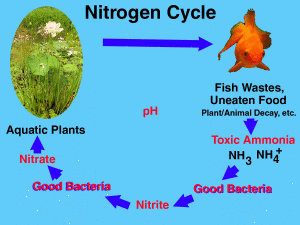The Nitrogen Cycle occurs naturally and invisibly on a microscopic level within a pond or water garden. It is a vital, natural process in all healthy, organic, aquatic ecosystems so it is good to know and understand this process and how it works.
First, the fish waste and uneaten food becomes Ammonia. Ammonia (NH3) can be an industrially produced chemical, and it also is created and exists naturally in the environment. Ammonia is essential for many biological processes and serves as a precursor for amino acid and nucleotide synthesis; the nitrogen cycle. In the environment, ammonia is part of the nitrogen cycle and is produced in the water from bacterial processes. Ammonia naturally occurs from decomposition of organic matter, including plants, animals and animal wastes. Basically, when the fish feed, their waste (along with uneaten food) becomes ammonia. The ammonia molecule is then turned into the nitrite molecule.
Nitrite is a waste produced by bacteria in the biological filter as it breaks down ammonia. Nitrite is extremely harmful to fish if left in quantities unconverted. Tested levels of 0.25 ppm or higher are dangerous to your fish and if levels are allowed to rise up to 0.5 ppm, it can result in severe fish loss..
Biological filtration provides the environment for this nitrogen cycle to take place naturally. In this cycle naturally occurring bacteria (nitrifying bacteria or aerobic bacteria) break down the ammonia into the nitrites, and then is converted further; produces the byproduct called Nitrates.
Nitrate is the byproduct of nitrifying bacteria in the biological filter breaking down ammonia and nitrite; Nitrate can be taken in by aquatic plants and algae as a nutrient for growth. High levels can lead to excessive algae growth. Levels should be kept below 40 ppm and should be tested weekly.
Thus, when the fish eat, their waste/the ammonia is converted by aerobic bacteria (the good bacteria) into the nitrites, and is further converted into nitrates. Nitrates then in this cycle become “food” for the plants to grow on (fertilizer) and then in turn, the fish eat the plant material as a food source, produce ammonia …..thus creating an on-going natural process called, completing the Nitrogen Cycle.
